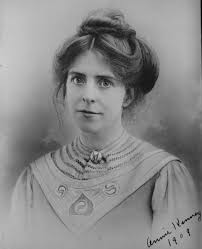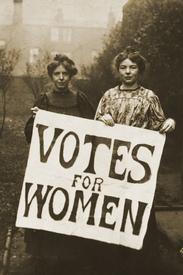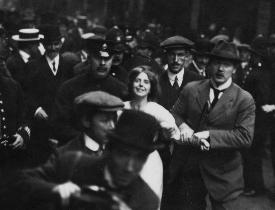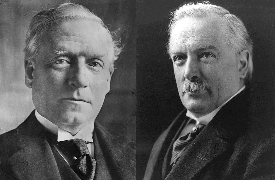Friday, 13th October 1905 was a dreary autumn day in Manchester, but there was excitement in the air. In the city’s trade hall, the Liberal party, at this time the only other major political party in Britain along with the Conservatives, were holding a meeting as they tried to gather momentum for the general election the following year. During the meeting a certain Winston Churchill, a young local MP and one of the most radical members of the Liberal leadership, took to the stage, but was interrupted during his speech by a question from a soft-looking, blue-eyed woman in her 20s. ‘If you are elected, will you do your best to make women’s suffrage a government measure?’ she asked. Churchill was hesitant, and appeared uncharacteristically lost for words. Receiving no reply, the woman and her friend unfurled a banner that had the slogan ‘votes for women’, and they were swiftly thrown out of the meeting and arrested.
Of the two women arrested that day in Manchester, one was suffragette royalty. She was Christabel Pankhurst, daughter of the famous campaigner Emeline Pankhurst and sister of Sylvia Pankhurst. Together, the Pankhurst women would go on to become the public face of the struggle to win women the right to vote in Britain. The other woman, who asked the question of Winston Churchill, is less well remembered but sacrificed just as much for the same cause. She had met Pankhurst only a few months previously and been utterly inspired, and her arrest that day was the first of 13 arrests she would rack up during her time as a campaigner. Her name was Annie Kenney, and she was not only a fierce campaigner for women’s suffrage but also a committed socialist. Her soft features disguised a steel inside her that led her to strike fear in the heart of the British establishment.
A childhood in poverty
Ann ‘Annie’ Kenney was born on 13th September 1879 in Springhead, which is now part of Greater Manchester, the fifth of eleven children born to Nelson Horatio Kenney and Anne Wood. The Kenney family were poor and none of the children received much formal education, although their mother taught all of them to read and write. As detailed by Spartacus Educational, Annie would later recall that her mother was an outgoing woman who encouraged her children to think openly and express themselves, while her father was a something of an introvert who ‘had very little confidence in himself.’
Like all of her siblings, Annie was forced to work from an early age to supplement the family income. She started work at a local cotton mill at the age of ten, losing one of her fingers to an accident soon after. She worked long hours and was expected to help with housework when she returned home, an expectation that made her develop a sense of solidarity with her mother, sisters and other women around her. This gender solidarity was complemented by her sense of class solidarity with the working-class people she grew up with, as she worked at the mill for a further 15 years and became involved in Labour and Trade Union politics.
Introduction to the Women’s suffrage movement
It was her involvement in Labour politics that led to her meeting with Christabel Pankhurst in early 1905. Pankhurst gave a speech on women’s voting rights at a Labour party meeting that Annie attended with two of her sisters, Jenny and Jessie. Annie was inspired by the charismatic Pankhurst and immediately joined the Women’s Social and Political Union (WSPU), which Pankhurst had recently formed with her mother and sister, and within months the two new friends found themselves interrupting Winston Churchill’s speech and being arrested after a policeman claimed Pankhurst spat on him as he tried to eject them from the meeting. They were given the option of paying a fine or going to prison, and they chose prison, knowing the publicity would rally more women to their cause. Sure enough, when Kenney was released after her short sentence she was greeted outside the prison by a crowd of supporters.
Rise in the WSPU
After her release, though Kenney had been scarred by the harshness of life in an Edwardian prison, she declared that there was no woman in the WSPU who would not gladly go to prison ‘to win freedom for her sisters.’ She began working for the organisation full time, moving to London to lead the WSPU branch in the city’s east end and developing a reputation as a passionate and charismatic speaker. She was also known for her publicity stunts. In 1906, after the Liberal party won a landslide victory in the election, Kenney led a group of women to the home of the Chancellor of the Exchequer (and future Prime Minister) Herbert Asquith. She knocked on the door incessantly and refused to leave, securing herself another short prison sentence. On another occasion, she unfurled a banner with the slogan ‘votes for women’ at the Royal Albert Hall.
In 1907, Kenney was sent to Bristol to run the WSPU in the west of England. It is interesting to note at this point that although she was fully committed to the organisation and felt a sense of gender solidarity with the Pankhursts and others, Kenney was one of the only working-class women who were given leadership roles in what was a very middle-class organisation. Kenney was a feminist but also a socialist, sympathetic to the plight of working-class men – many of whom also did not have the right to vote – and carefully supportive of the truly radical economic reforms the Liberal government started to implement in 1906-1914.
Still, the government was not paying attention to calls for women’s suffrage, so more drastic action needed to be taken. Kenney was heavily involved in the increasingly militant tactics of the WSPU, which included vandalism, arson and chaining themselves to railings. In one instance, a bomb was exploded outside the summer home of the new Chancellor of the Exchequer (and another future Prime Minister) David Lloyd George. The WSPU were always careful to ensure there was no violence inflicted on people – Lloyd George and his family were nowhere near the home when the bomb went off – but the destruction of property was enough to provoke a reaction from the government, and scores of suffragettes were marched off to prison during this time.
The WSPU then directed their members to go on hunger strike in prison, which meant they would refuse to eat and let themselves become seriously ill. It was certainly an outlandish idea but there was a degree of genius to it – the government could not afford to let the women die in their prisons, if for no other reason than it would be a PR disaster. Kenney herself fully understood the power of PR and imagery, going on hunger strike and ensuring that upon her release from prison she was seen at meetings, carried on a stretcher, too ill to stand up. To make oneself so dangerously sick takes phenomenal courage and commitment, qualities which Kenney had in spades.
The First World War
Events appeared to be reaching a climax. In 1913, the government introduced the Cat and Mouse Act, which would allow for women on hunger strike to be released from prison and then thrown back in once they had recovered from illness. The previous year, Christabel Pankhurst had fled to Paris to avoid arrest and left Kenney in charge of the whole organisation. Unrelenting as ever, she denounced the Cat and Mouse Act (indeed, she was the first woman to be released from prison under the act) and decided that the WSPU had no intention of letting up their militant campaigns or hunger strikes. In June 1913, Emily Davison was killed as she tried to attach a suffragette slogan to the King’s horse during a race in Epsom. It is doubtful whether Davison intended to kill herself – she had purchased a return train ticket – but Kenney ensured she was treated as a martyr. Slowly but surely, votes for women was edging closer. The new Labour party were likely going to insist that all their candidates for Parliament at the next election support women’s suffrage, and Sylvia Pankhurst was in secret talks with David Lloyd George.
Herbert Asquith (left) and David Lloyd George (right) were the targets of WSPU publicity stunts and were starting to come round to the idea of votes for women before the outbreak of WWI. Annie Kenney would go on to work closely with Lloyd George during the war
But then, suddenly, Europe was plunged into war. The suffragette movement was split, between those who wanted to carry on the fight against a distracted government and those who wanted to pause the fight and throw their weight behind the war effort, out of a sense of patriotism and a sense that it would be good for their public image. Annie Kenney was in the latter camp. Together with the Pankhurst women she toured the country speaking in support of the war and encouraging women to support the national effort. The WSPU’s newspaper, Suffragette, was discontinued briefly but returned in the middle of the war with a new name, Britannia, and launched vicious attacks on people deemed not to be supporting the war effort enough.
In 1915 Kenney started working with David Lloyd George, now Minister for Munitions, to call on women to work in British factories. Millions of women heeded the call, stepping up to replace the men in manufacturing and agriculture. Kenney was now something of an insider, speaking regularly with Lloyd George and leading public anti-communist demonstrations, a seemingly odd turn for a woman who had been a socialist in her youth.
Though votes for women was probably assured without the war, it was the war that persuaded any lingering doubters that there was no justifiable reason for denying women the vote. Kenney and her comrades had supported the war out of a genuine sense of patriotic duty, but that did not mean that they were not aware of the fact that their support would ensure they received great publicity.
Later Years
Before the war was even over, the government passed the Representation of the People Act. This gave women over 30 the right to vote, providing they or their husband owned some property. It is limited by modern standards but it gave the vote to two thirds of British women, which was a start that was much more promising than most suffragettes had originally hoped for. In any case, all men and women over the age of 21, regardless of property ownership, were given the right to vote in 1928.
Kenney effectively retired from public life after the war, marrying James Taylor in 1920 and giving birth to their son, Warwick, in 1921. The family settled in Hertfordshire, where Kenney wrote her memoirs, Memories of a militant, in 1924. She continued to write to Christabel Pankhurst and agreed to occasional interviews during her retirement, but her campaigning days were behind her. Annie Kenney died on 9th July 1953, at the age of 73, after a gradual decline in her health. James Taylor was certain that the hunger strikes had contributed to her death.
Annie Kenney is not as well known as the Pankhursts or some other suffragette figures, perhaps because she was a working-class girl working in an organisation dominated by women from respectable middle-class families. Yet her work was every bit as important as that of her more famous comrades. A plaque in her honour was unveiled in 1999 at the mill she used to work at, and in 2018 plans for a statue in her honour in Oldham, Greater Manchester, were submitted.
Acknowledgements
The Ministry of History is not an academic source. Our pieces are written by writers who have been studying history for years and are well versed in, and influenced by, countless other writers and works. For this article specifically our sources have included:
'Annie Kenney', article published by spartacus-educational.com
'Annie Kenney', article published by wcml.org.uk (Working Class Movement Library)
'Annie Kenney: Statue to mark 'overlooked' suffragette', article published by BBC News
Images
Cover Image - wikipedia.com
Image one - commons.wikipedia.org
Image two - thesun.com
Image three - thehistoryofparliament.wordpress.com



